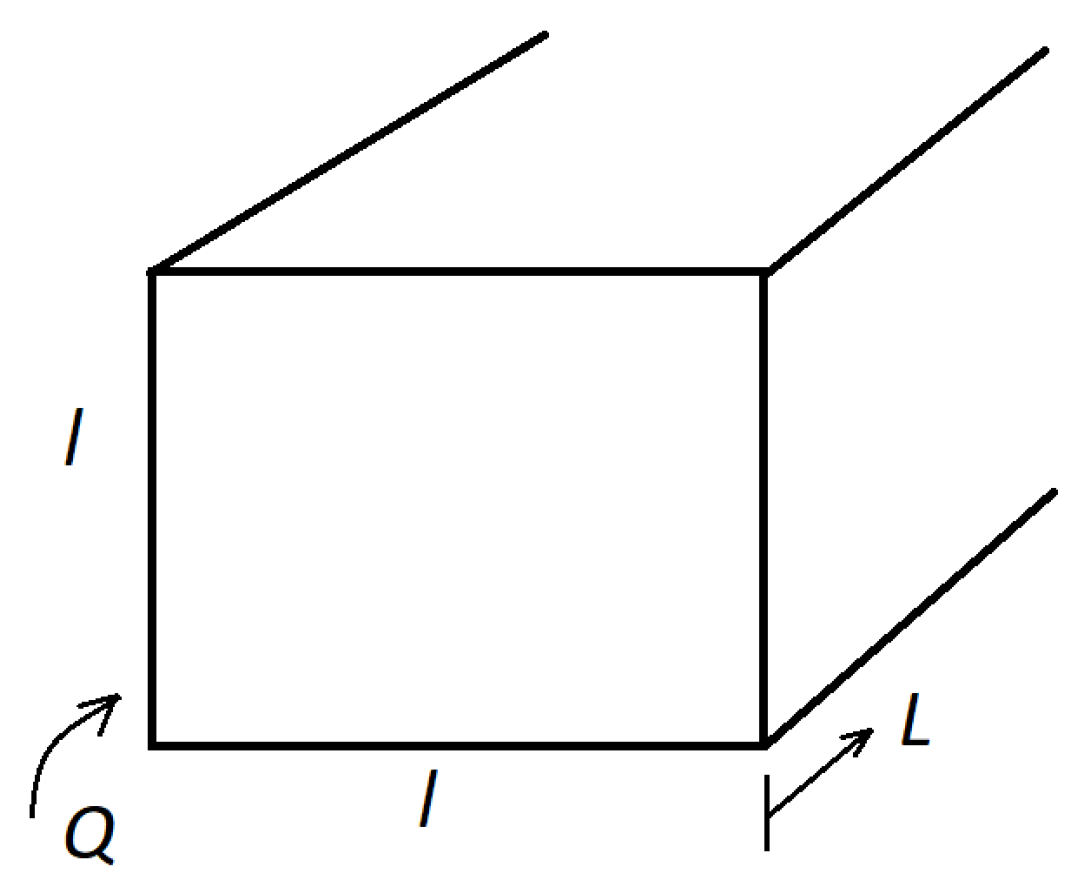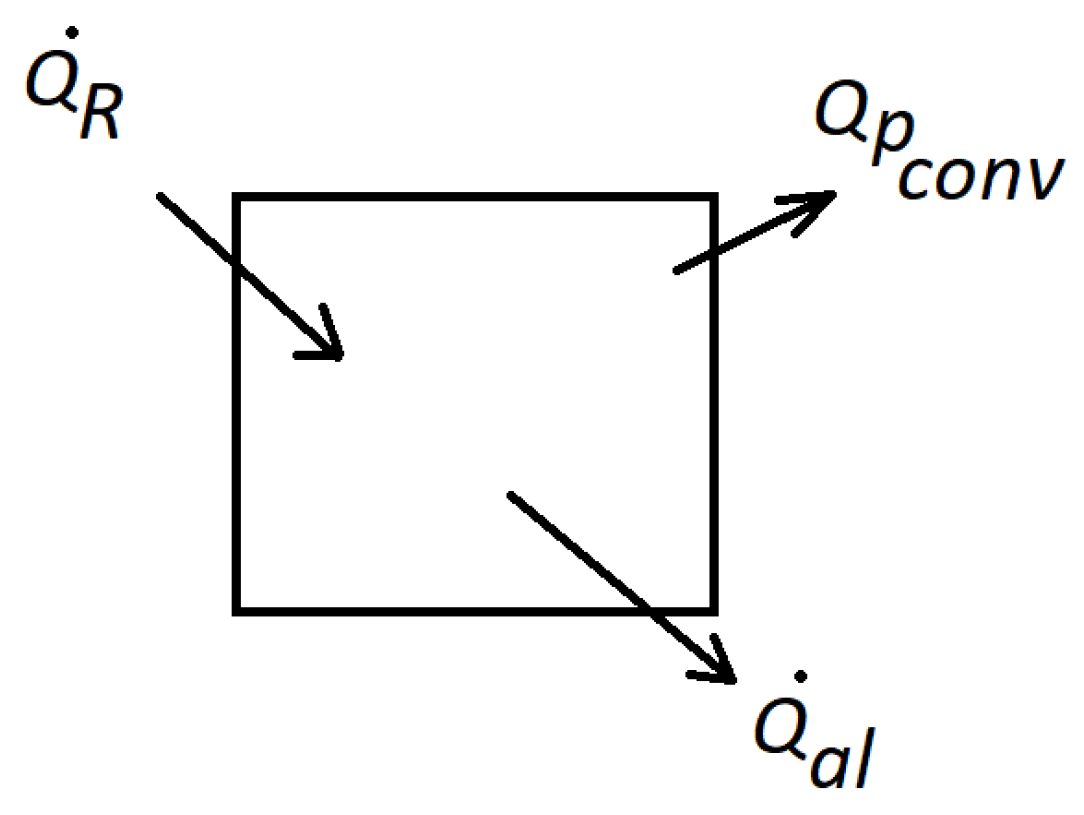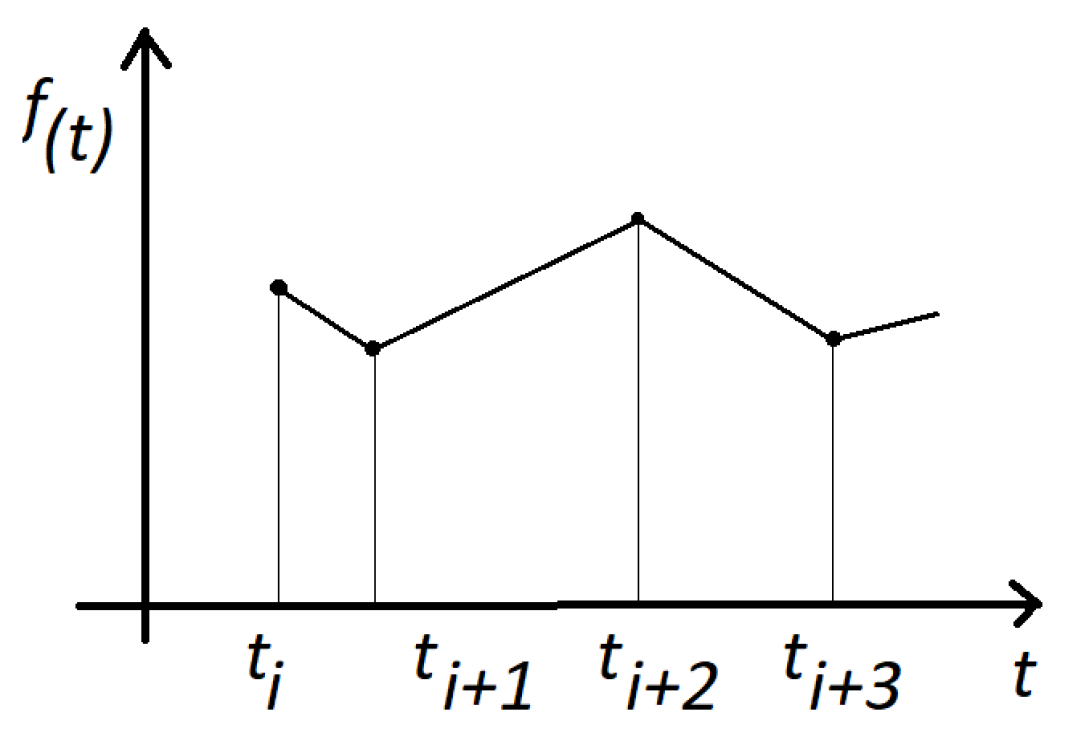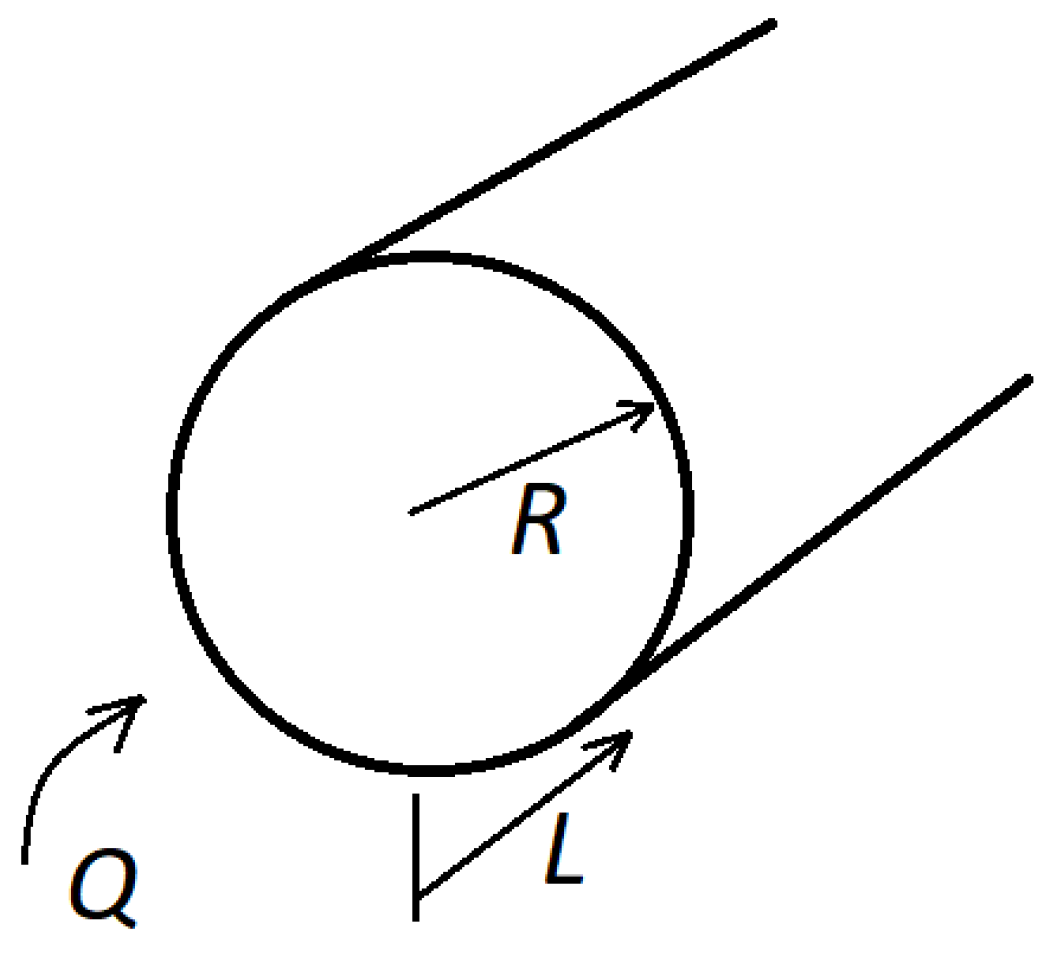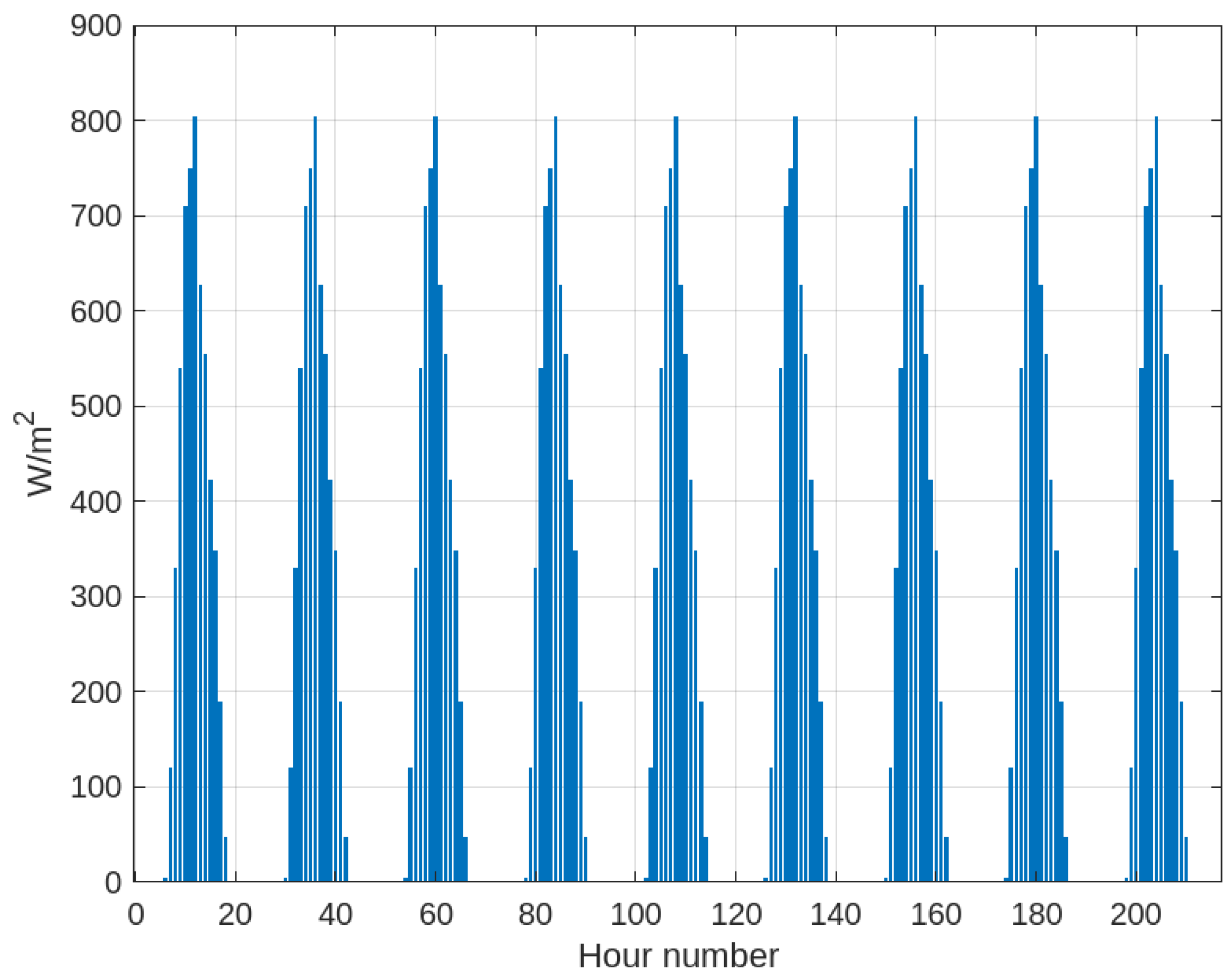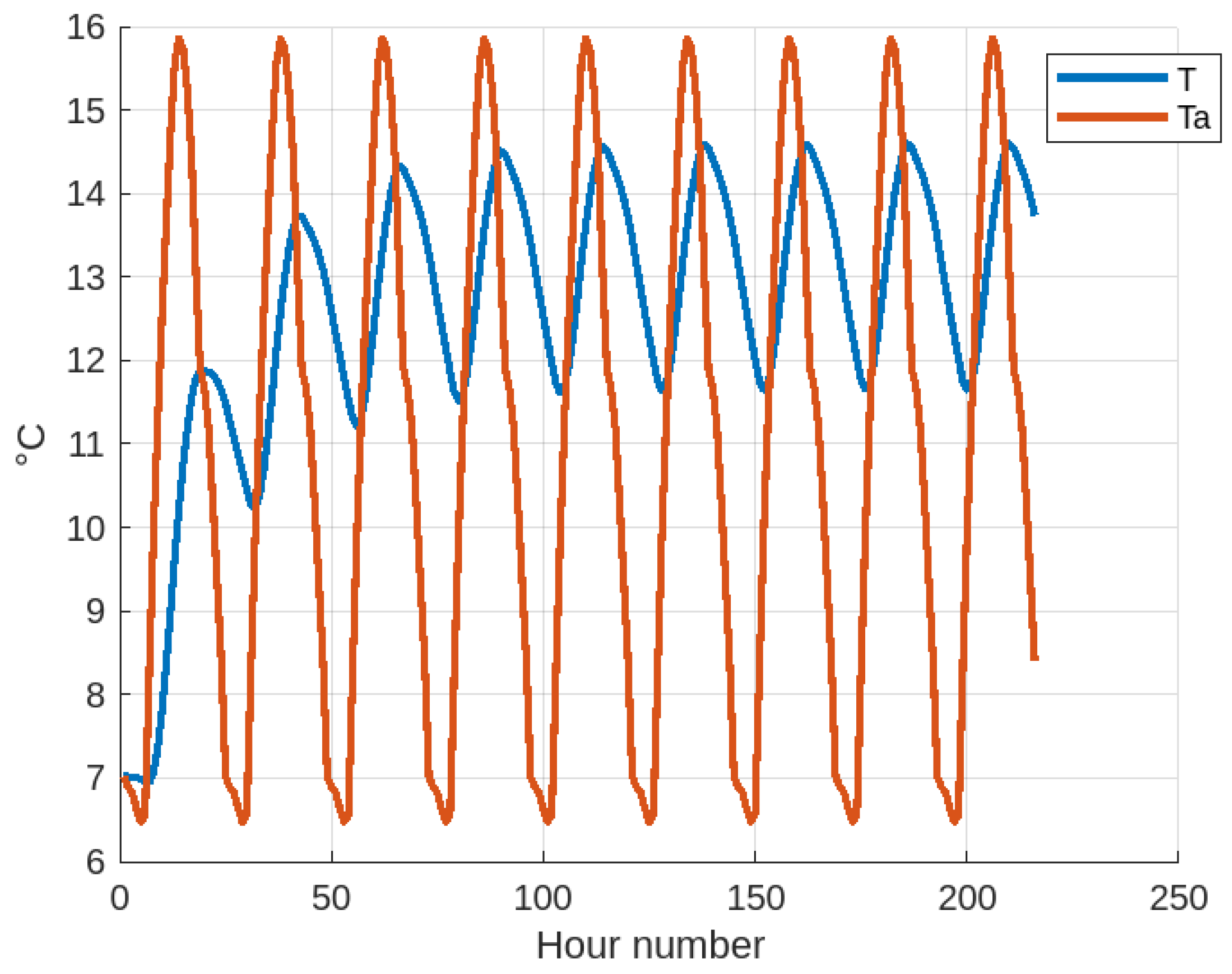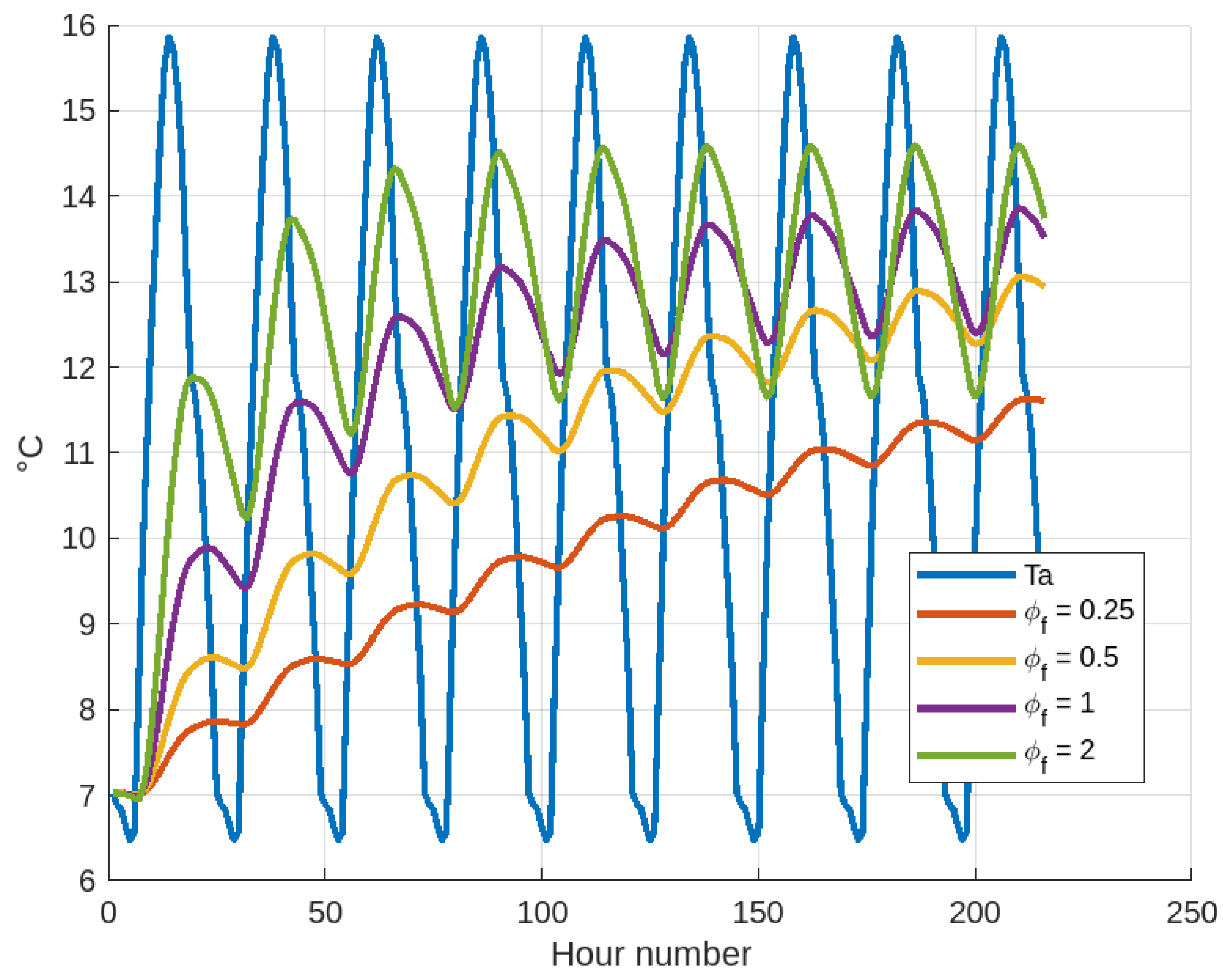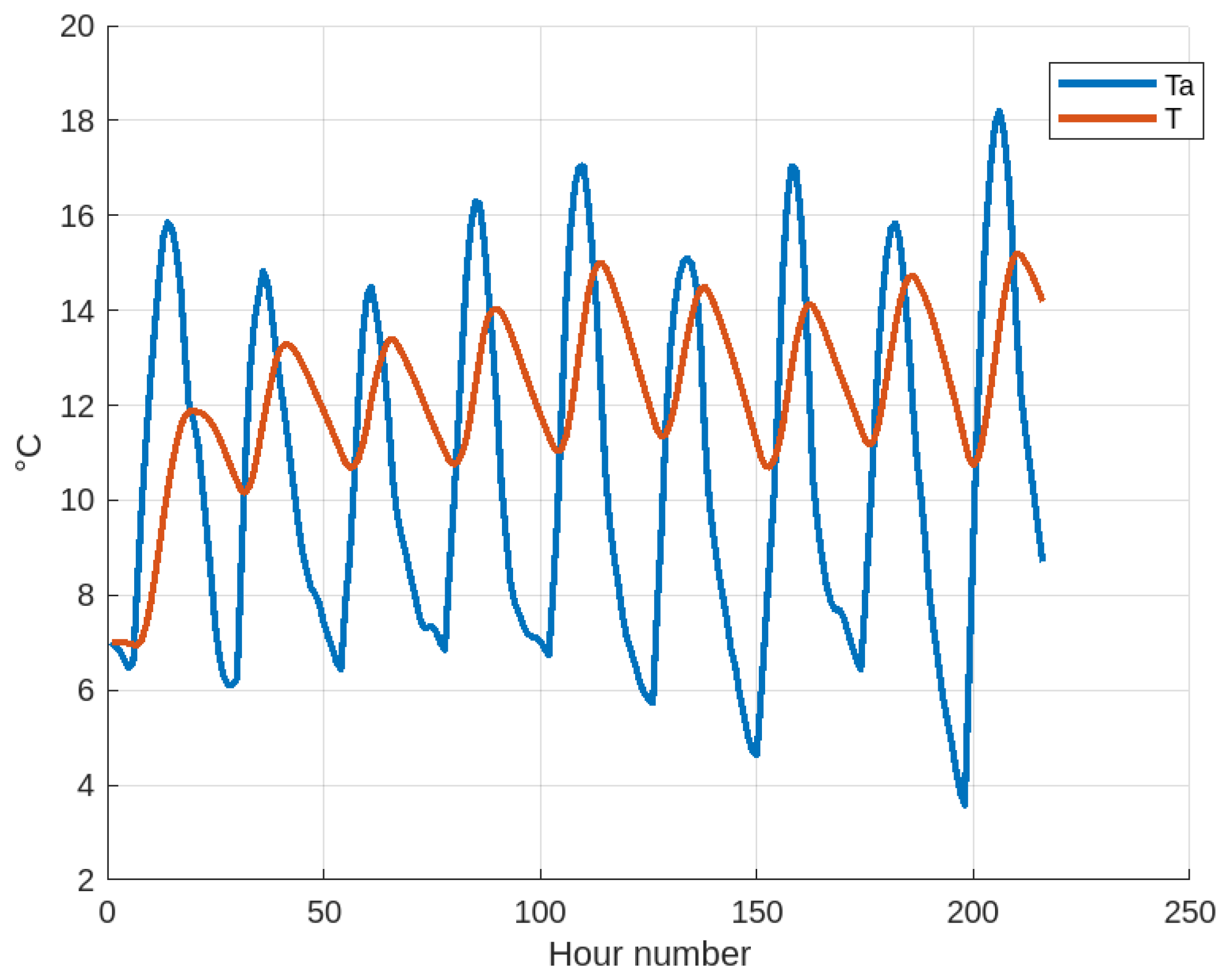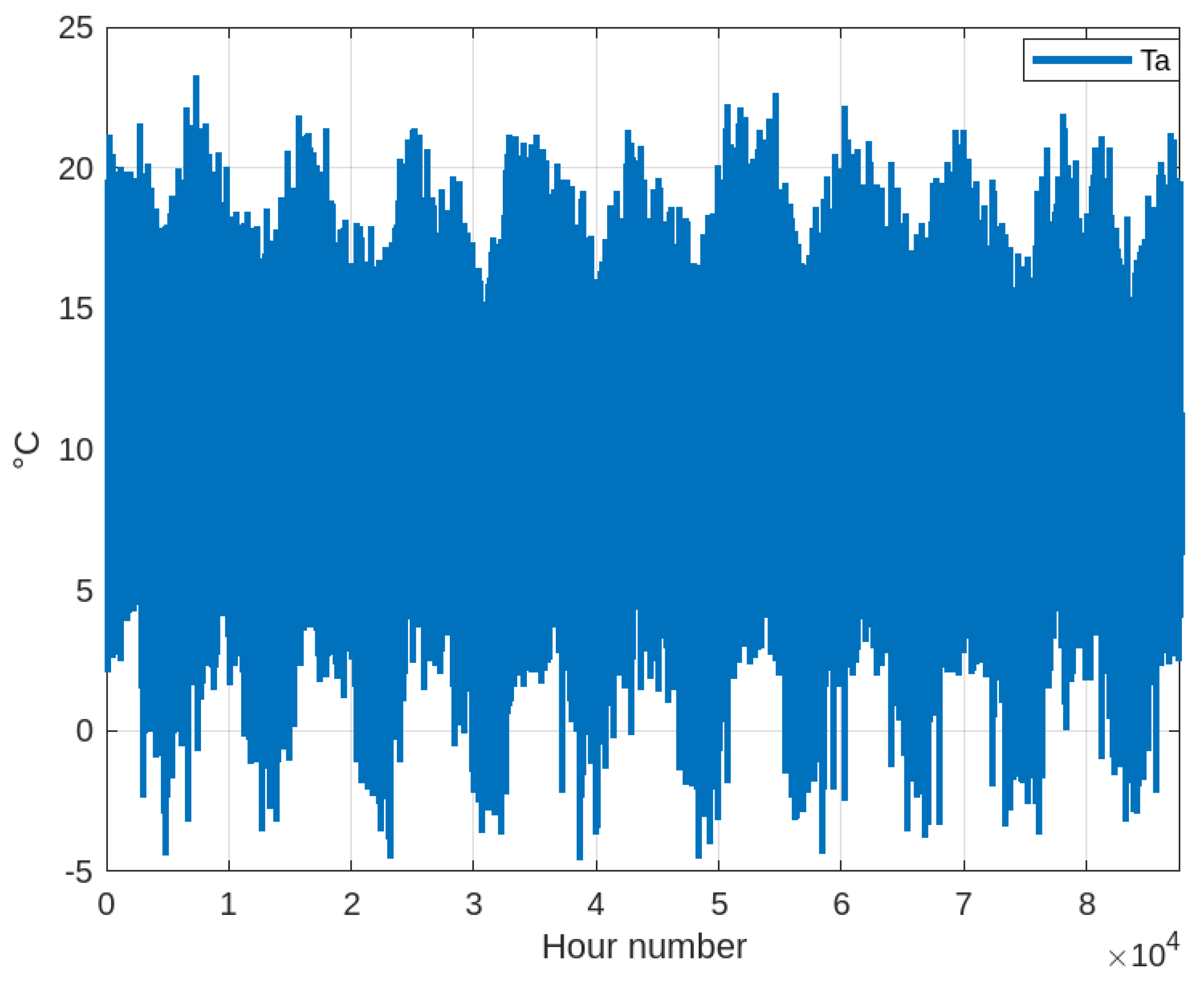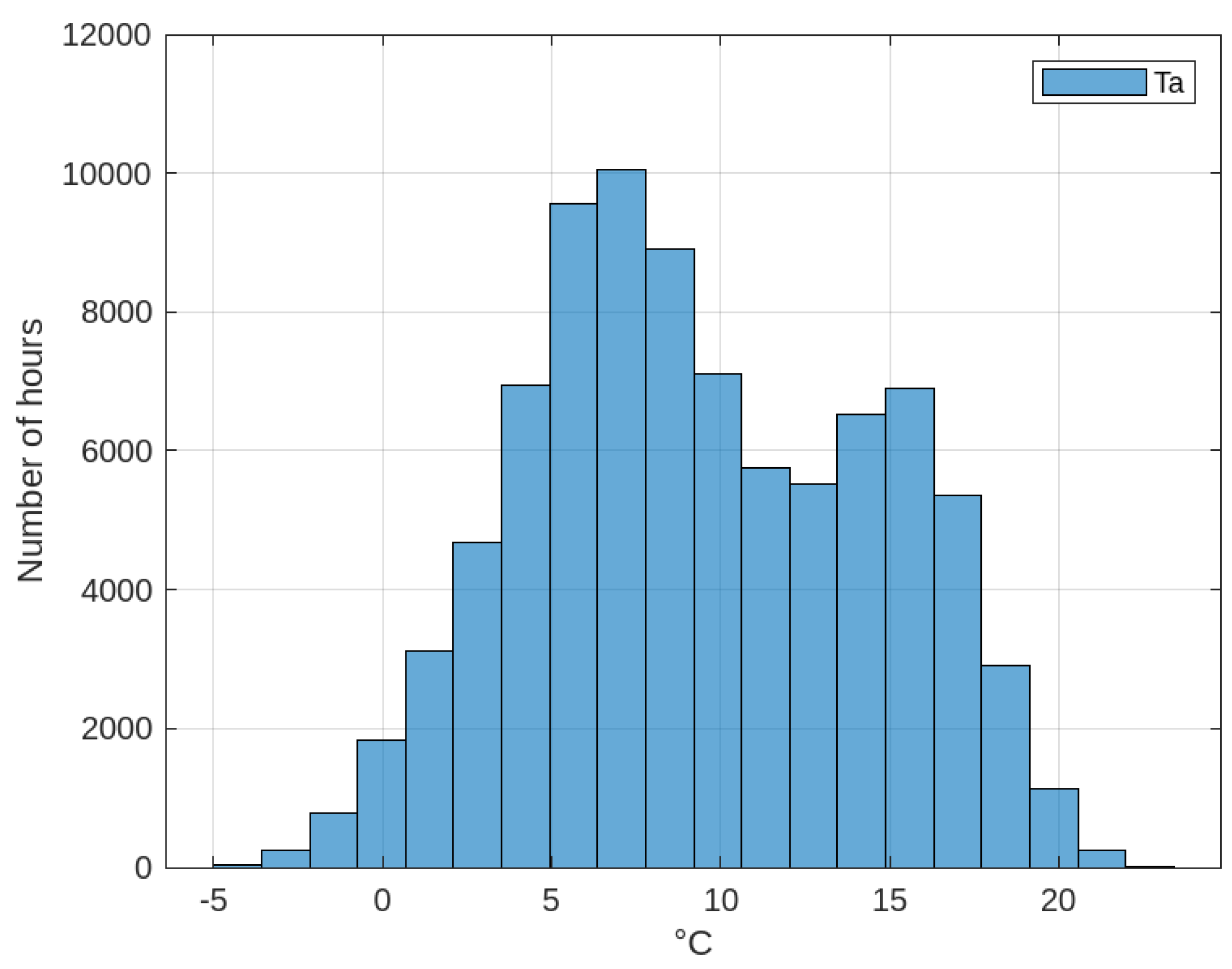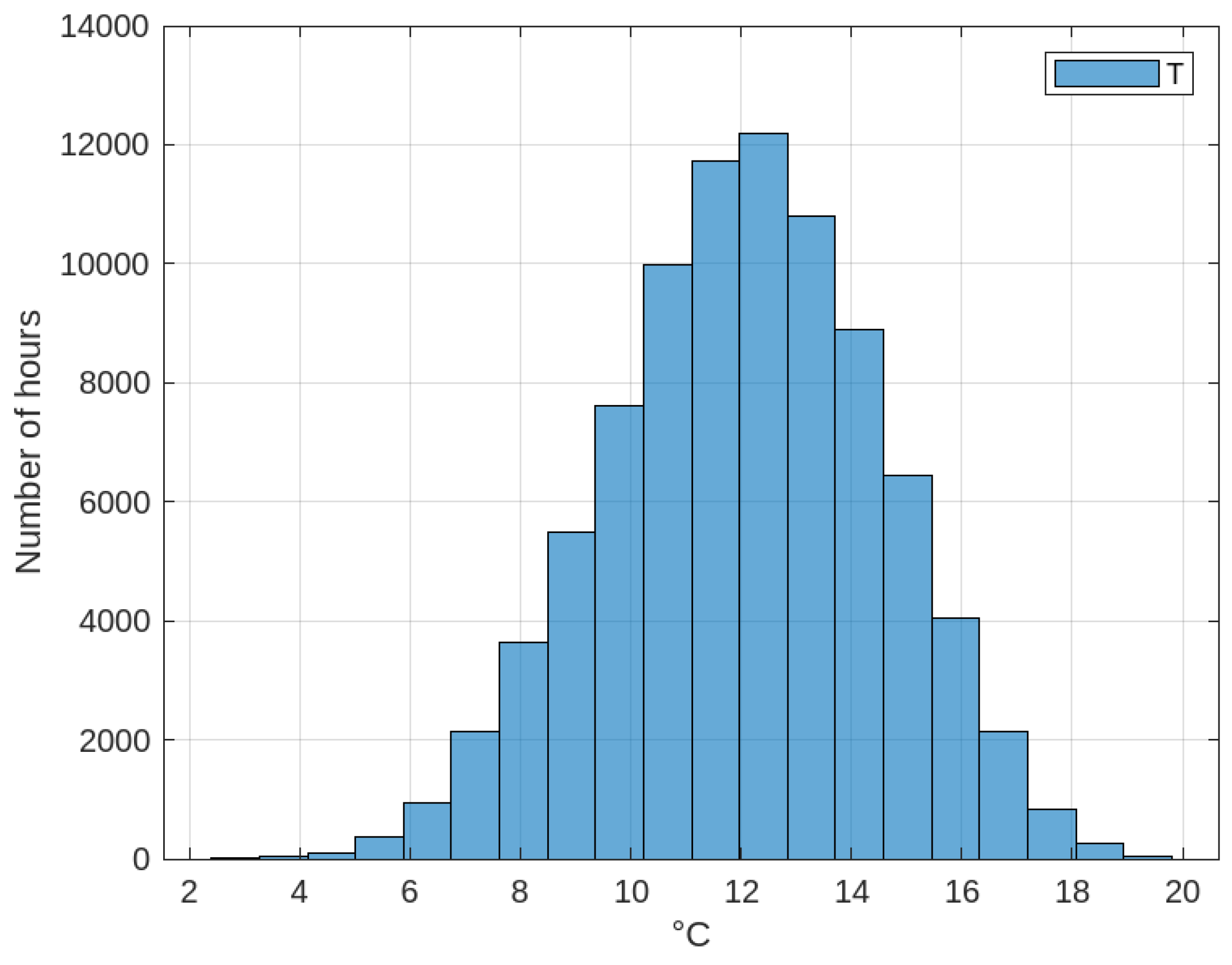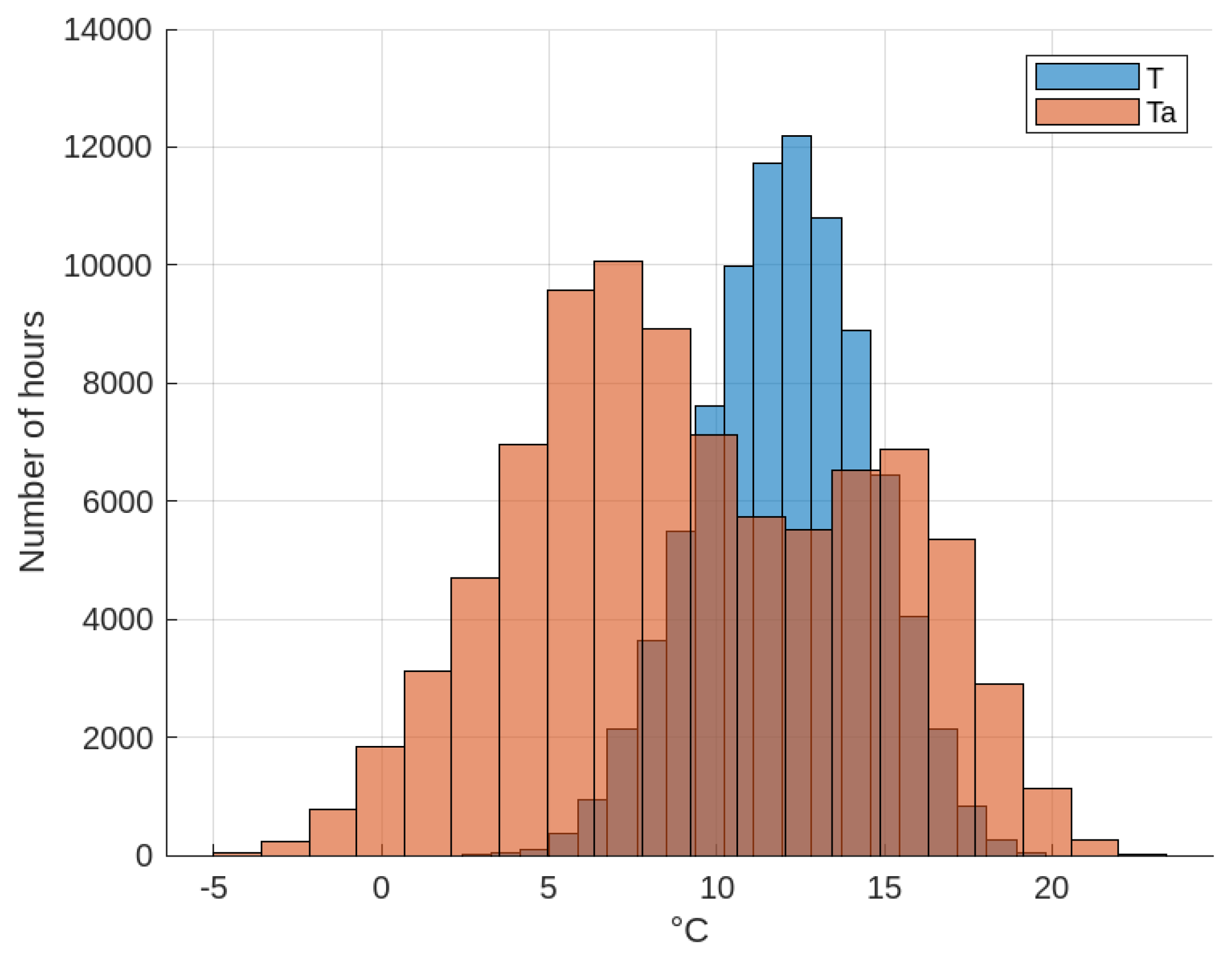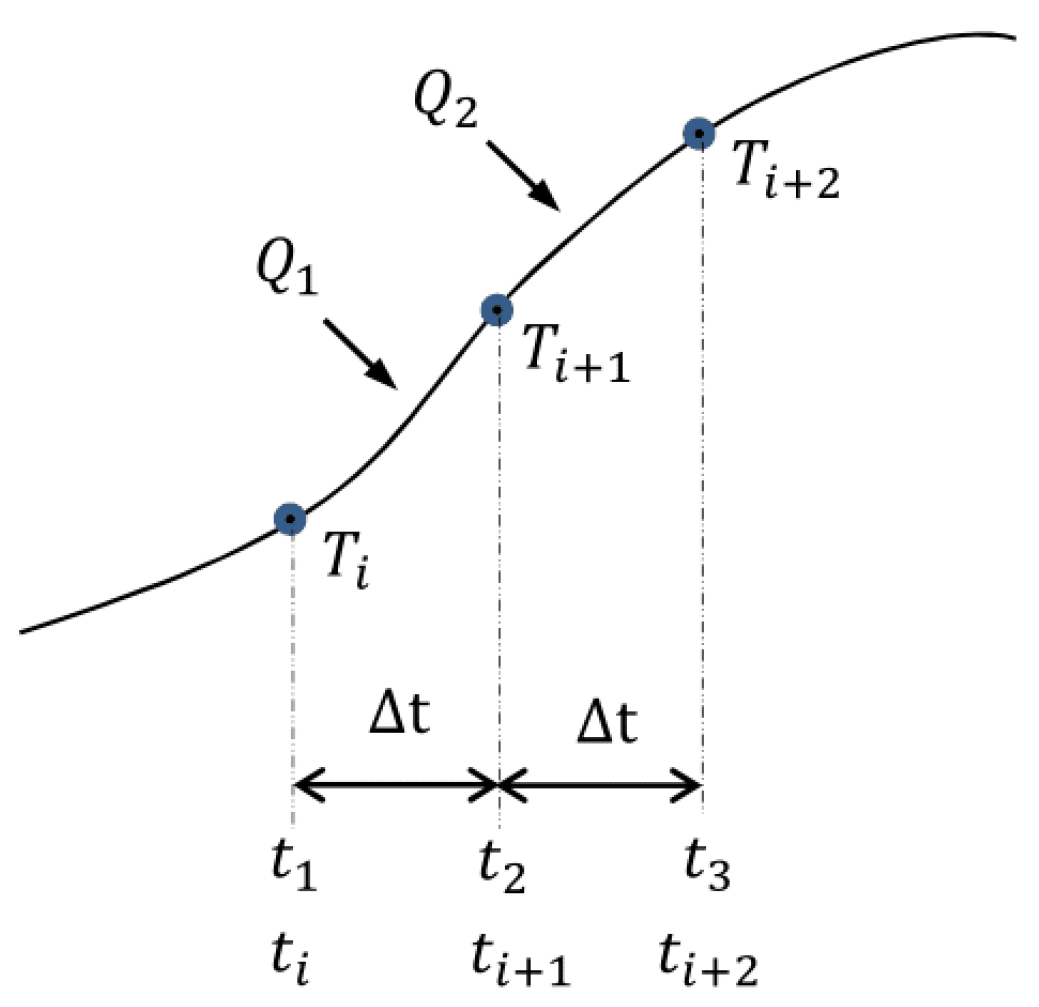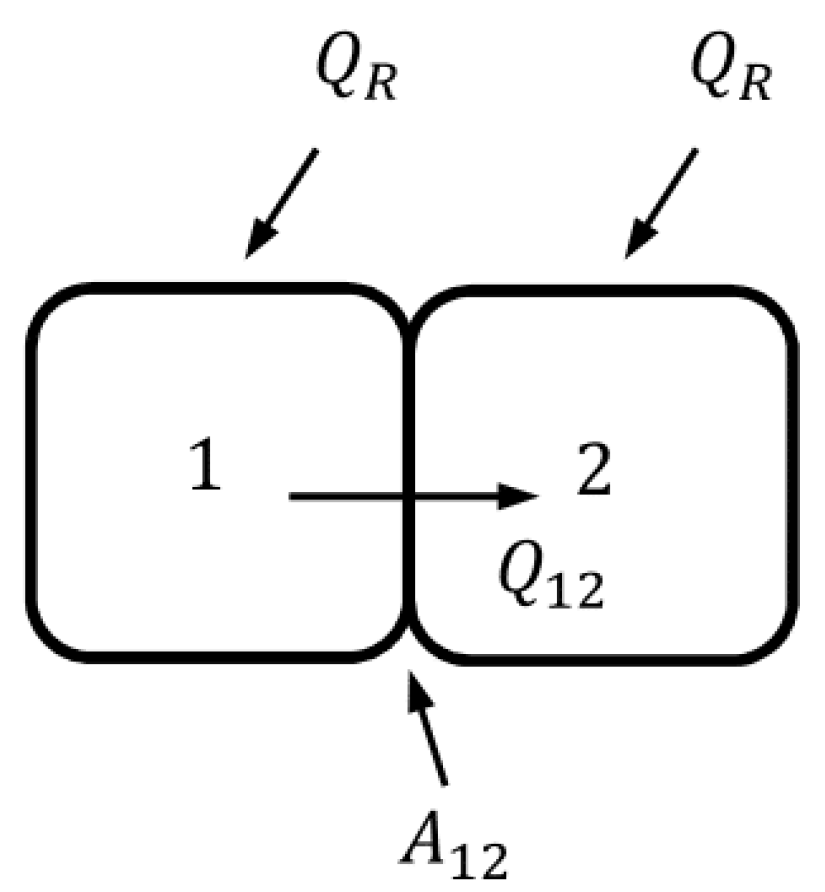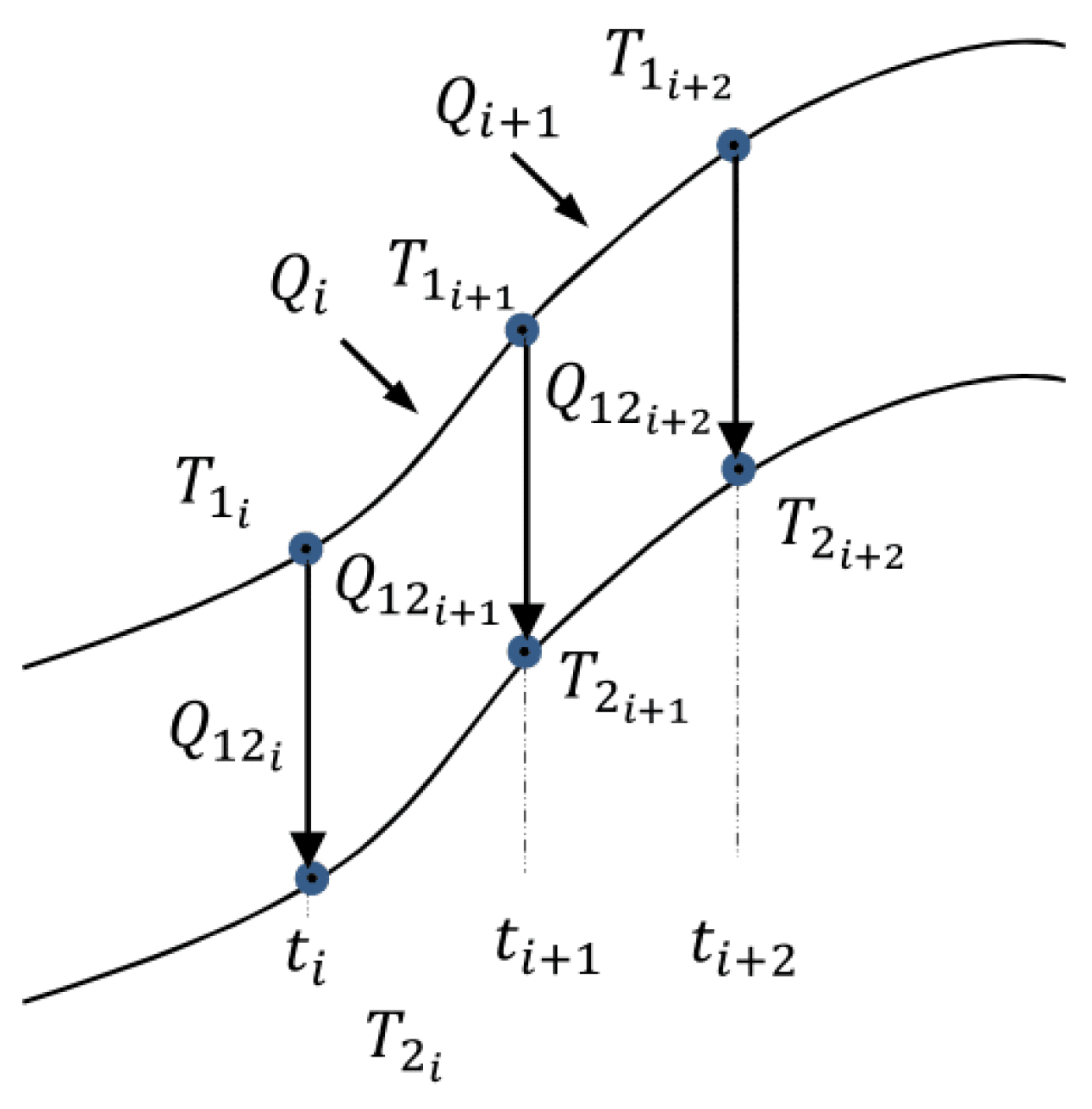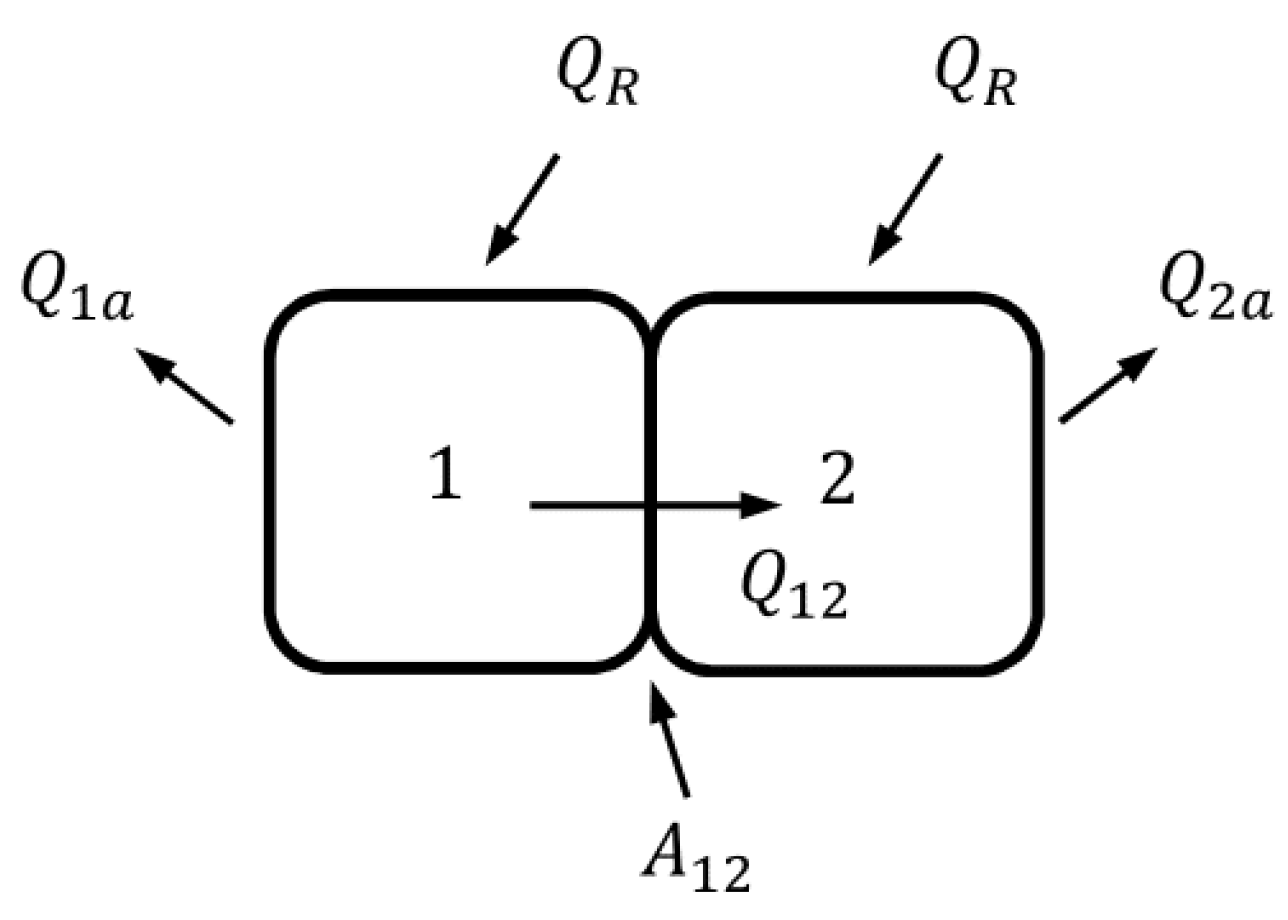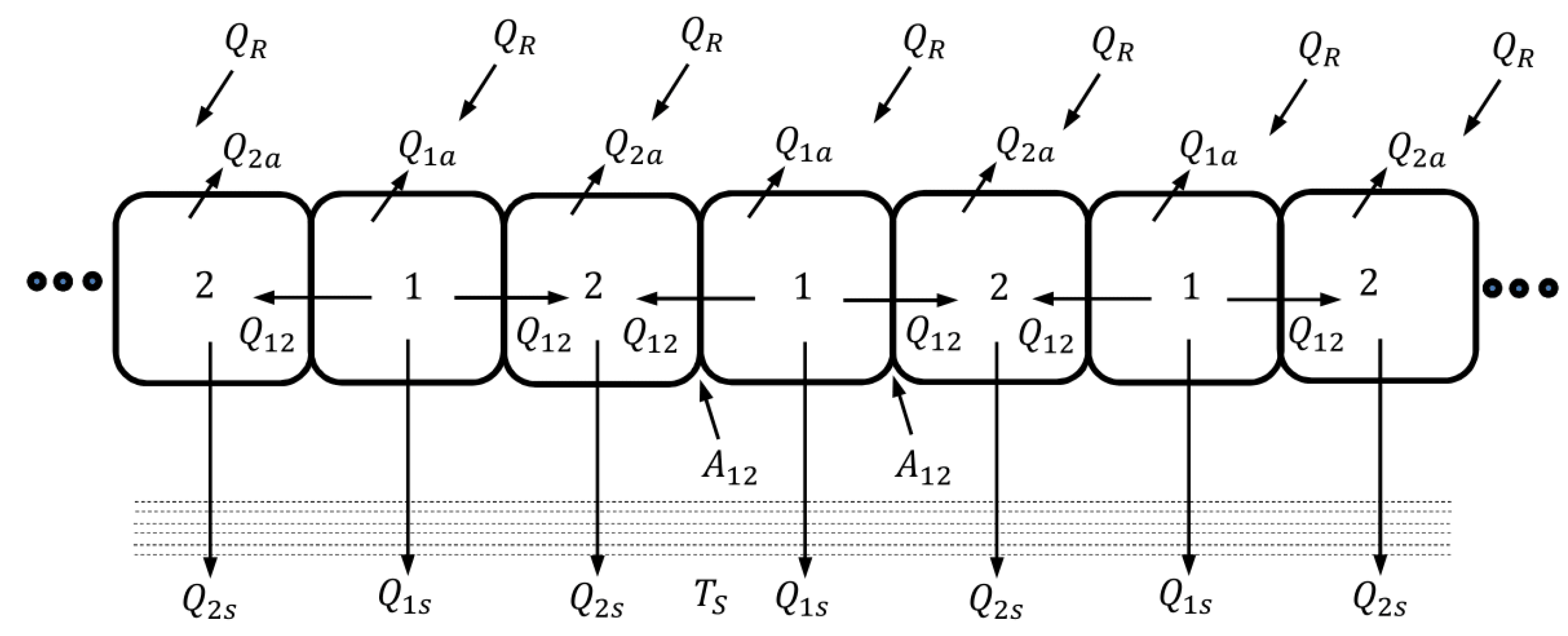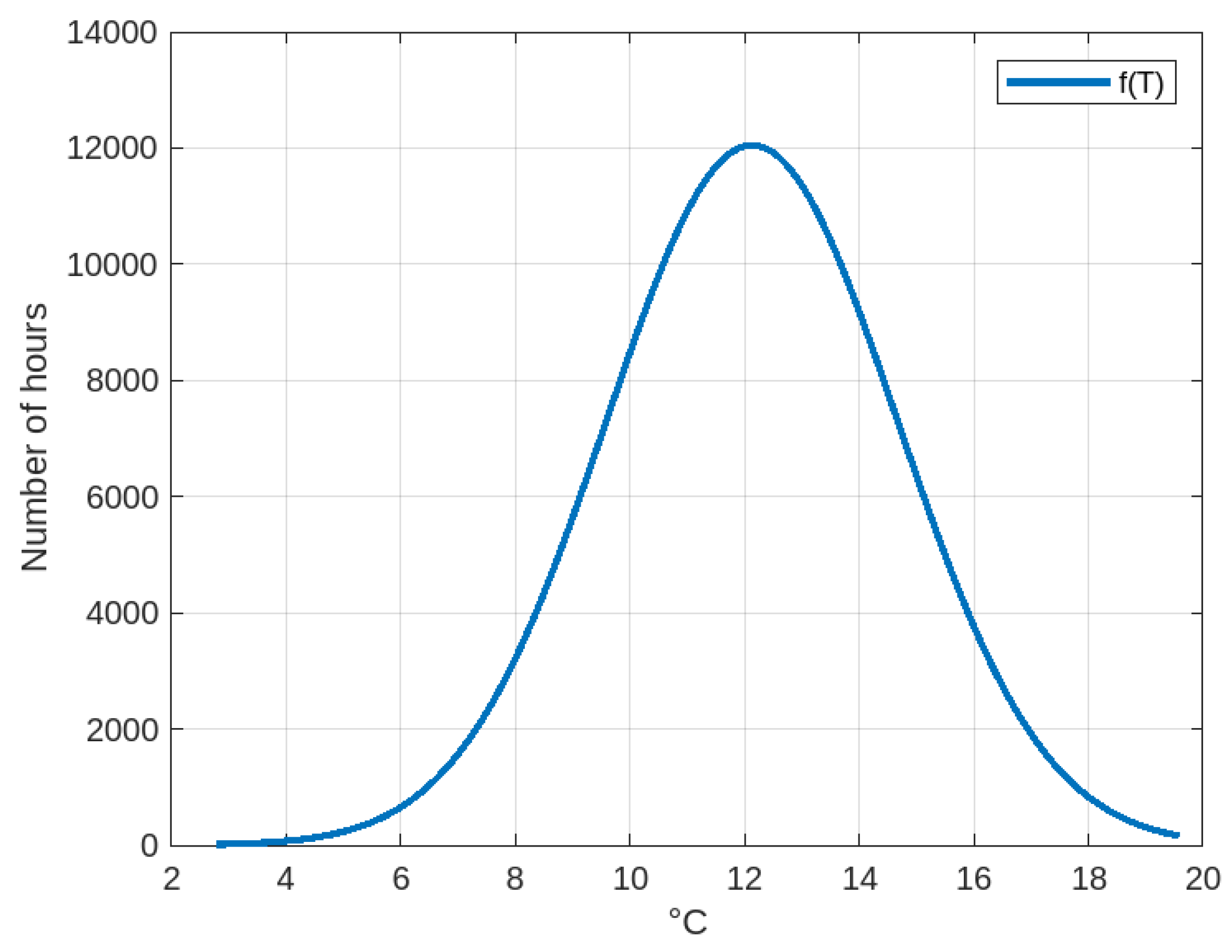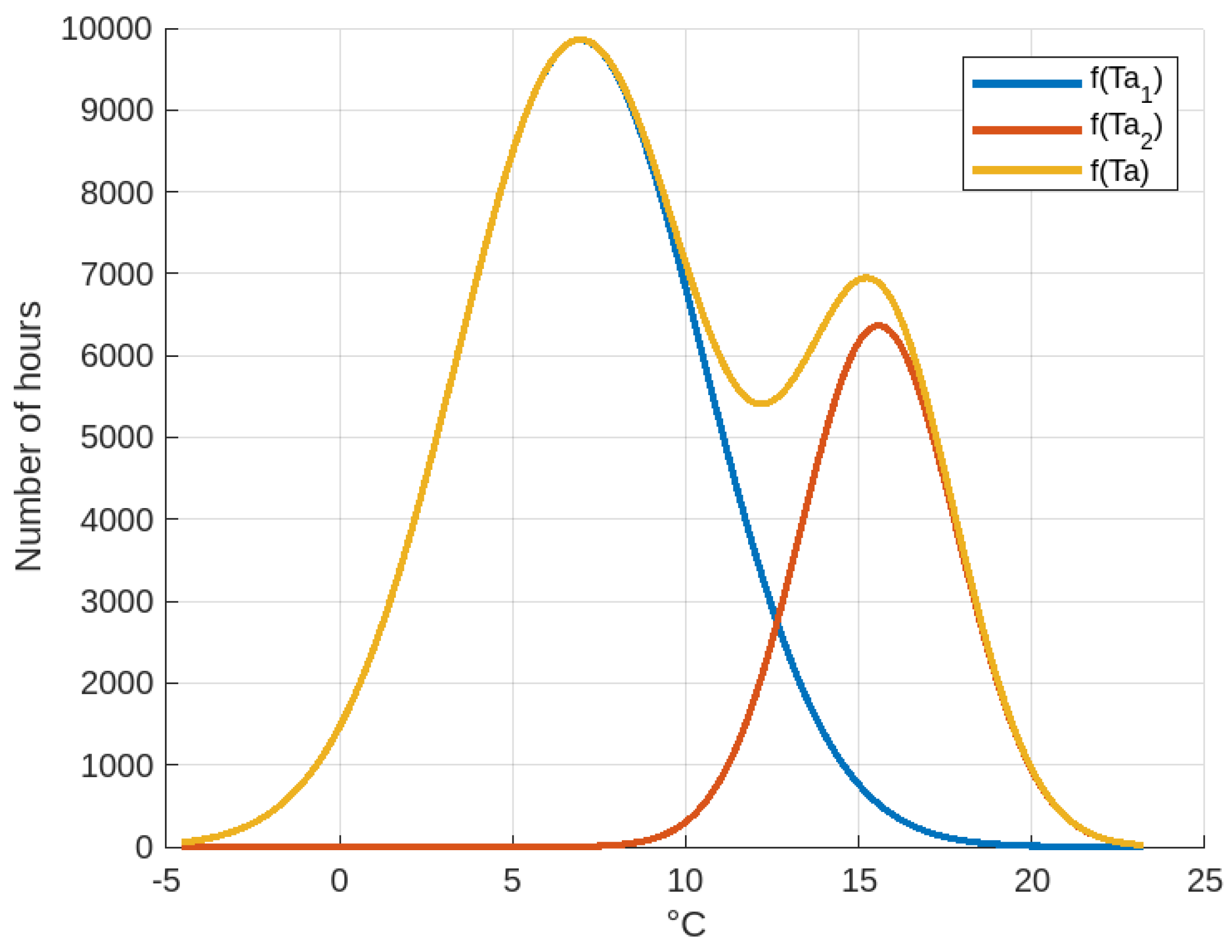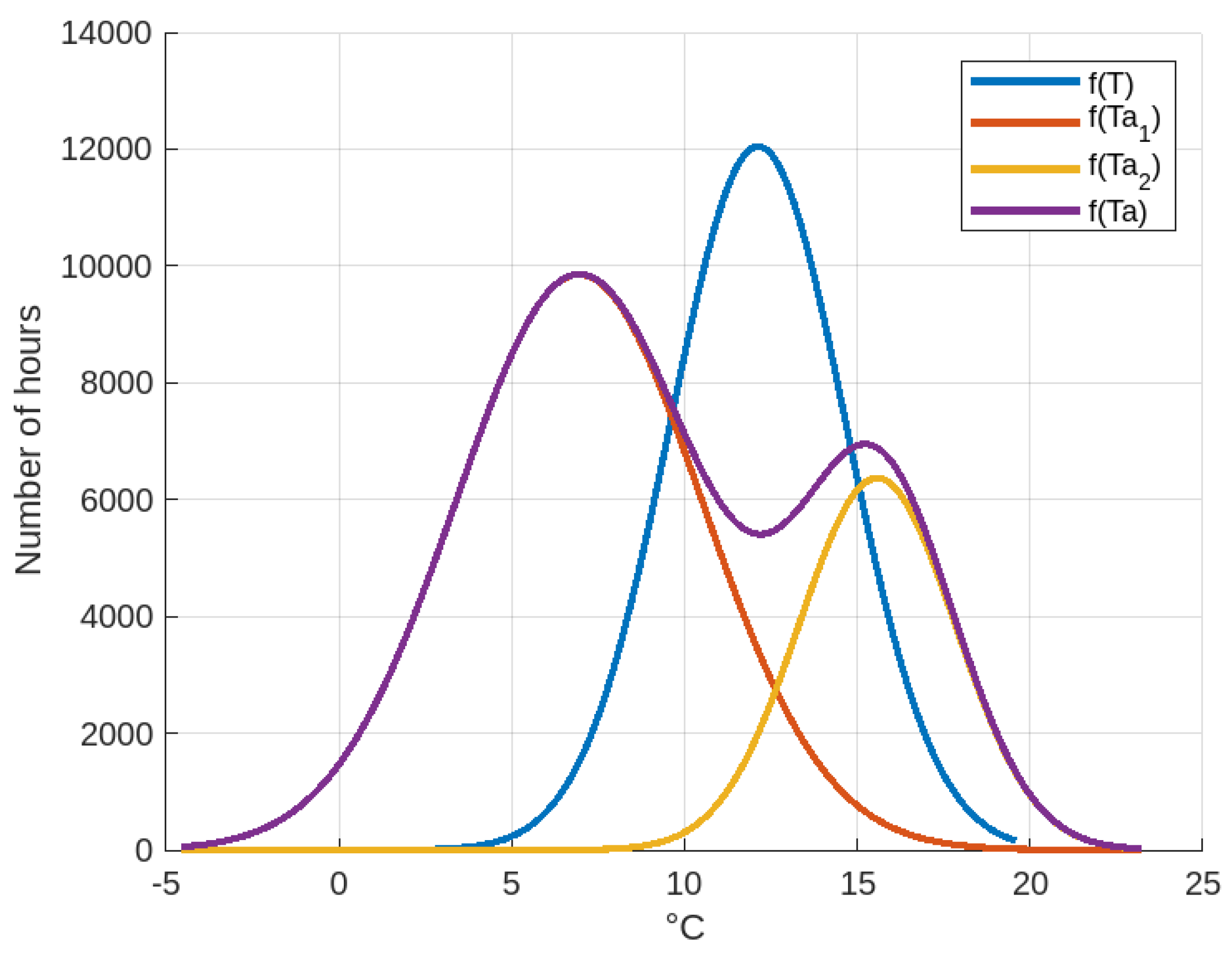1. Introduction
Sustainable thermal energy storage systems (STESSs) have been important since ancient times for various applications, including agriculture. An ancestral STESS technique that has been used for hundreds of years until today is the “Waru-Waru” technique (WWT), implemented in cultivated fields located in the south-west of Peru 3800 m above sea level and within the vicinity of Lake Titikaka, where low temperatures occur throughout the year.
A schematic representation of the “Waru-Waru” technique implemented in field crops is shown in
Figure 1, where 1 represents soil platforms, 2 indicates water channels, and 3 denotes the subsoil, which is a soil–water mixture with high water content due to the proximity of Lake Titikaka (similarly to the function of a phreatic layer). Crops are planted on the soil platform. Due to their high thermal storage capacity, water channels behave as thermal energy storage systems, capturing part of the energy coming from the sun during the day and returning part of the accumulated thermal energy to the surrounding environment during the night to maintain the microclimate at appropriate temperature values so that the crops on the soil platform do not die or suffer damage.
In [
1], it is reported that, in the Lake Titicaca region, there are more than 82,000 hectares of agricultural fields built by pre-Hispanic cultures using the “Waru-Waru” (WW) agricultural technique, which extends into part of what is now Bolivia and Peru. These agricultural fields are made up of platforms that vary in height from approximately 0.2 m to potentially more than 1.2 m, with widths ranging from 2 to 20 m and lengths extending from 2 m to several hundred meters. They are elevated above the original soil surface and are encircled by canals that measure between 1.6 and 4.5 m in width. This innovative farming technique was employed during the time of the Tiwanaku Empire (pre-Hispanic culture that developed between 1000 BC and 1000 AD) as a means to mitigate damage to potato crops (Solanum tuberosum) caused by hail storms, short droughts, and mid-growing-season frosts, which could have occurred individually or at the same time in the high-altitude Altiplano region (a region located between 3800 and 4000 m above sea level). However, the precise dimensions of these ancient raised fields have been challenging to establish due to the platform erosion and the soil accumulation within the canals. Also, in this study, the frost mitigation effects of raised fields of varying dimensions at two different locations within the Lake Titicaca region has been assessed, with the aim of understanding which physical mechanisms proposed are most likely responsible for the observed frost mitigation, but it is important to note, however, that the climate over 2000 years ago was significantly different from what we see today.
The main motivation for the present paper is the complex models reported in [
2] where a vegetation–atmosphere transfer model based upon a two-layer scheme of the surface–atmosphere interaction is shown and includes a substrate layer representing a water-filled canal, alongside a vegetation layer that corresponds to the crops cultivated on the platform. The energy and mass transfer processes that occur in the air within the high field system are described by this model. But the model implicitly assumes that the pre-Incas (/Incas) had knowledge about air vapor pressure, air specific heat at constant pressure, saturated vapor pressure at certain temperature, incoming long-wave radiation, aerodynamic resistance, psychometric constants, air density, water available energy, conductive flux of heat, the Stefan–Boltzmann constant, water emissivity, crop emissivity, water density, specific heat of water, and air humidity, among others. Additionally, these are variables that require sensors and measuring instruments to quantify, which were not available in pre-Inca/Inca cultures (1000 BC–≈1532 AD). However, everything indicates that there was sufficient knowledge in mathematics and physics (according to archaeological evidence and recent use as detailed in the following paragraphs). Therefore, it is possible to hypothesize that the main criterion of the WWT was that it is purely of practical application, a mixture of physical principles and experiments to achieve the best possible adaptation of crops to the environment and soil of a specific area of cultivation without knowing or considering many physical variables or advanced mathematical concepts, which are necessary to achieve practical and widespread application of the technique.
In [
3], it is described that some of the most remarkable remnants of ancient ridged fields can be found in Colombia, Bolivia, the Orinoco Llanos, Surinam, and Ecuador. These fields feature parallel or irregular arrangements of elevated ridges that vary in height, width, and length; they range from a few inches to several feet in height, approximately 10 to 70 feet (approx. 3 to 21.3 m) in width, and extend up to several thousand feet in length. However, the most extensive area of ancient ridged fields identified in the Americas is located in the Lake Titicaca region in Peru, on relatively flat terrain at elevations between 3800 and 3890 m above sea level, with an estimated area under ridged field patterns of 78,104 hectares. The major areas of this kind are the pampas of Taraco and Juliaca to the north-west of the lake, and the pampa of the Ilave delta to the south-west. Between Lake Umayo in the west and the Capachica peninsula in the east, the ground is covered with ridged fields of various kinds over an area of more than 200 square miles. At the southern end of the lake, three important groups of fields are located on marshy ground at Pomata, Desaguadero, and Aygachi. But there are also numerous small and dispersed areas, none exceeding 1000 hectares. These areas typically occur in marshy depressions or along valley floors, often positioned away from the river’s course and adjacent to the steep slopes that transition into mountainous terrain. These can be found in close proximity to the lake, situated at a relatively low altitude relative to the lake’s surface. Over 92% of the fields lie within 30 km of the lake. While the lake has an average elevation of 3803 m, 98% of the fields are located below 3850 m, with the highest fields reaching an altitude of 3890 m above sea level. The moderating influence of Lake Titicaca on the climate of the area is certainly of considerable importance in present-day agriculture. The patterns of ridged fields vary greatly over the whole area and are as follows:
open checkerboard, where the ridges are not continuous, there are no surrounding embankments, the average width of ridges and troughs varies from 5 to 20 m, and the length varies from as little as 2 m to 40 or more;
irregular embanked patterns, consisting of groups of ridges that are sometimes enclosed or partially enclosed by low embankments, which in some cases are circular or near-circular, and in others highly irregular;
riverine patterns;
linear patterns;
‘ladder’ patterns, the fifth type of ridge pattern; and
combed fields of Aygachi, which are roughly parallel and curvilinear ridges (2 to 6 m in width), grouped in bundles of 5 to as many as 35 strips and from 20 to 150 m in length. This is interesting, but there is no mathematical model that explains the diversity of patterns, shapes, sizes and locations. This would have required many calculations for each particular case and implementation/construction adjustments at the location.
In [
4], findings from archaeologists are reported which indicate that raised-field agriculture has historically been more efficient and productive than what is currently practiced in the region: dryland farming. However, this study also highlights the long-term failures of several raised-field rehabilitation projects, which raises questions about these findings. For that reason, the authors re-evaluated the energy efficiency, labor requirements, and production levels associated with raised-field agriculture, and concluded that traditional dryland farming is somewhat more efficient than raised-field agriculture, which contradicts the existing literature. In the Titicaca Basin, there are relics of approximately 1200 km
2 of raised fields, and most of them—approximately 80%—are situated near Juliaca (Peruvian city located at a distance of approximately 23 km from Lake Titicaca at its closest point), which is located within a triangular region of about 950 km
2 that includes the towns of Lampa, Paucarcolla, and Taraco. In the Western Hemisphere, there are four large concentrations of pre-Hispanic raised fields; one of them is in the Titicaca Lake Basin. Raised-field agriculture garnered significant admiration in Peru and Bolivia during the late 1980s and early 1990s, and has been celebrated as an indigenous technology that remarkably adapted to the challenging weather conditions of the
altiplano. The author considered it an indigenous technology that had made fields with high agricultural production possible in these extreme environmental conditions. Due to the ‘hyperproductivity hypothesis’, raised fields have consistently demonstrated higher energy efficiency compared to traditional rain-fed agricultural systems in the region, highlighting their significance in the political economy of the Titicaca basin, since the author considers that the nature of pre-Hispanic agriculture in the elevated fields located in the
Altiplano is somewhat misunderstood. These fields produced potatoes, and it has been demonstrated that the water in the canals between the platforms positively impacts the microclimates of raised fields. During the day, the water absorbs solar energy, which it then radiates to the surrounding soil and air at night, helping to regulate local temperatures.
Other similar techniques include greenhouses, which consist of an infrastructure (usually made of metal) and a cover over the entire infrastructure, thereby creating a greenhouse effect by taking advantage of solar radiation. Case reports of greenhouses mention that they make the following possible: temperature regulation using phase-change materials and sustainable growth of crops, as described in [
5]; hybrid passive cooling and heating system, as described in [
6]; extending the vegetation period of crop plants as described in [
7]; and thermal batteries as described in [
8]. However, infrastructure is needed to cover large cultivation areas, involving a large amount of materials, sophisticated logistics, and high costs.
In the described context, the WW technique was implemented in a considerable area organized into different sizes and shapes, requiring planning and the appropriate calculation of such shapes and sizes for each place in which WW was built. Therefore, calculation was performed according to the calculation tools of the time such as quipu and yupana that allowed operations such as addition and multiplication. However, the mathematical models cited are complex and do not explain the diversity of models, shapes, sizes and locations of the WW. Two hypotheses are proposed and argued that correct existing mathematical models: (1) basic physical principles, which Inca cultures used as a first approximation, and (2)—based on the first—they experimented and made appropriate adjustments to their technology to adapt to the changes in the environmental conditions of the soil and air in each particular place where they implemented it. To affirmatively support these hypotheses, this article presents mathematical arguments demonstrating that these pre-Hispanic cultures had knowledge in mathematics and physical principles that they used in this technique, through a combination of mathematical calculations and experiments in real scenarios, using calculation tools based on addition and multiplication, with which they were able to build WW in large areas and that have worked for hundreds of years. This fits with the current trends of agronomic practices to enhance the resilience of crops to extreme climates, as mentioned in [
9].
The remainder of the article is structured as follows:
Section 2 presents a first idealized modeling of heat transfer over bodies of square and circular sectional areas considering that heat flows towards the body in a uniform way. This is because both the ground platform and the water channel can be considered to have a square or rectangular sectional area, and the edges of the soil platform can suffer erosion, losing their sectional area shape and changing that of the water channel. In extreme cases of erosion of the edges, the soil platform may become a semicircular sectional area with the plant at the center (at the highest point), and similarly, the sectional area of the water channel takes on a semicircular shape due to the material deposited by the erosion of the soil platforms. In
Section 3, a mathematical model of heat transfer between bodies with different thermal properties is progressively constructed—emulating the WW arrangement of soil platforms and water channels, alternating in a large extension of cultivation area—to obtain the equations that determine the evolution of the temperatures of the soil platforms and water channels considering thermal energy storage and solar radiation.
Section 4 presents an analysis of the feasibility of the experimental implementation of the WWT in crop fields, obtaining a set of parameters that quantify and represent the thermal characteristics of the soil (which itself is a mixture of organic material, clay, stones, roots, and others) and water (which is actually a mixture of water as an aqueous substance, microbes, bacteria, insects, insect material, etc.), and which are used in the equations that determine the evolution of the temperatures of the soil platforms and water channels. The discussion is shown in
Section 5, and conclusions are presented in
Section 6.
3. Mathematical Model—Second Approximation
The typical configuration of the WWT is the alternative placement of soil and water, which have different thermal behavior in energy storage and thermal energy exchange between themselves and between them and the air. This section shows a mathematical model that shows the behavior over time of the soil and water temperatures conditioned by the temperature of the environment, the solar radiation that influences both, and the temperature of the subsoil (located below the soil–water arrangement that exists on the surface of the crop field).
Let us take the general heat equation described in Equation (
62), where
is the density,
c is the specific heat capacity, and
k is the thermal conductivity of the substance, representing the variation of temperature in space and time due to the entry of heat or the generation of heat inside the substance.
An equivalent temperature is considered for the temperature change that occurs in the medium, and, therefore, there is no temperature variation inside the substance, leading to Equation (
63) since the body would behave as a point element in which there would be no temperature differences between the outside and inside of the body. That is to say, a body whose temperature is uniform at all points is considered. In the case of the WWT, temperature control is performed every hour, enough time for the temperature variations within each part of the WW to be considered uniform and stable.
The concept of the derivative can be represented using incrementals by Equation (
64), which is substituted into Equation (
63) to obtain Equations (
65) and (
66), where
is the diffusivity of the substance (
) under study.
The energy flow readings and temperature readings are considered to be discrete with a certain time interval between readings
that is uniform for all the process; therefore,
,
,
,
and so on. Additionally, during each time interval
, there would be an input of thermal energy specific to that interval, that is,
,
,
, and so on, as shown in
Figure 16. In this manner, Equation (
66) can be discretized and expressed as Equation (
67), where
is the time interval number and
is the net heat that is captured by the substance.
In the
Section 3.1 of this paper, it is assumed that
is a constant value, i.e., it does not change over time since
,
c and
k do not vary. This is given that the mathematical model developed is considered as an approximation to the description of the real process.
3.1. A Body with Convection Losses
Since each period between readings is listed with
i, the heat
is equal to the heat of solar radiation
minus convection heat
, which is energy that is returned to the environment, as can be seen in Equations (
68) and (
69), where
is the convection coefficient of the material,
the body temperature,
is the temperature of the environment around the body, and
A is the area through which thermal energy flows by convection. Equation (
67) under these considerations is written as Equation (
70).
This one-body behavior will then—in the following items—be extended to two bodies: one will represent the cultivation soil that has water on both sides, and the other will represent the water. Together, they represent a thermal energy storage system intended for agriculture called WW, which has been used for centuries and is becoming important today as a measure to counteract global warming and climate change.
3.2. Two Bodies in Contact and Different Thermal Properties—Without Convection
Figure 17 and
Figure 18 show the flow of thermal energy by radiation and conduction and the evolution of temperatures that lead to obtaining Equations (
71) and (
72), where it is understood that
and
are the heat values that affect bodies 1 and 2, respectively.
The heat flow by conduction
applied to the case under study is obtained by Equation (
73).
Thermodynamics states that heat naturally moves from an object with a higher temperature to one with a lower temperature, resulting in the flow of thermal energy. Assuming that the heat by conduction goes from body 1 to 2, Equation (
74) is obtained.
Furthermore, considering that the radiation
that both bodies 1 and 2 receive is equal, then Equations (
75) and (
76) are obtained, where
is the thermal conductivity coefficient that allows the passage of thermal energy from body 1 to 2;
is the equivalent area through which the flow of thermal energy occurs between bodies 1 and 2 (or area of interaction by conduction between bodies 1 and 2); and
is the equivalent distance (distance between centers of mass) between bodies 1 and 2. It is assumed that the rest of the surfaces do not intervene in the process, that is, they are adiabatic.
So, by rearranging Equations (
75) and (
76), Equations (
77) and (
78) are obtained, which allow us to determine the temperatures
and
.
3.3. Two Bodies in Contact with Different Thermal Properties and Convection with the Air
It is considered that
and
are the convection losses of each body, as shown in
Figure 19, and whose mathematical expressions are shown in Equations (
79) and (
80). Then, the heat fluxes in each period
i are shown in Equations (
81) and (
82).
Therefore, by rearranging Equations (
81) and (
82), (
83) and (
84) are obtained, which allow us to determine the temperatures
and
.
3.4. Three Bodies in Contact with Different Thermal Properties and Convection with the Air
Figure 20 shows an arrangement of bodies 1 and 2, which are considered to be of different nature (they are different material substances); for example, in the case of a WW, the materials are soil and water. Under these considerations and continuing the same conduction and convection procedure, Equations (
85) and (
86) are obtained.
3.5. Many Bodies in Contact with Different Thermal Properties and Convection with the Air and Conduction with Soil
This is the most general case, and as shown in
Figure 21, the arrangement consists of many bodies 1 and 2. In addition, there is interaction by conduction with the ground, which is described according to Equations (
87) and (
88). Under these considerations and continuing the same conduction and convection procedure, Equations (
89) and (
90) are obtained.
Therefore, what has been shown in (
89) and (
90) means that the thermal behavior has been generalized: as long as there are many bodies 1 and 2, the thermal behavior of bodies 1 and 2, whatever their location in relation to the crops, will be the same.
4. Feasibility of Experimental Implementation
Equation (
89) of
is an expression that depends on the previous temperature values and solar radiation, as shown in Equation (
91).
Equation (
91) can be simplified to Equations (
92)–(
96), which contain constant coefficients since the properties of the materials and geometries are conserved.
Finally, Equation (
92), which is used to determine the temperature evolution in body 1, can be expressed as shown in Equation (
97).
For body 2, a procedure similar to that carried out with Equation (
89) is carried out with Equation (
90) and whose ordered expression is shown in Equation (
98), which depends on the previous values of temperature and solar radiation.
Equation (
98) can be simplified to Equations (
99)—(
103), where coefficients are used that contain the properties of the materials and that, together with the geometries, are preserved.
In both Equations (
97) and (
99), there are five coefficients to be determined: those in Equation (
97) are
,
,
,
, and
, while those in Equation (
99) are
,
,
,
, and
. If temperature and solar radiation data are taken, the values of the coefficients can be determined. Therefore, as there are 5 coefficients to be determined, at least 5 readings are required; then, Equation (
97) is written in the form shown in Equation (
104) to determine the change in the temperature readings.
On the right side of Equation (
104), it can be observed that the expression
is present in all the components, which makes it feasible to take it to the left side of the equality, and then, the equations to determine the value of the coefficients
and
with field readings are written as Equations (
105) and (
106).
Once the coefficients , , , and have been determined, the values of the other variables involved can be deduced.
5. Discussion
The Inca and pre-Inca cultures have long been considered outstanding for their technological achievements, including high-altitude agriculture. As written above, it should be considered that understanding their technologies and techniques involves a mixture of physical principles and high mathematics that can be conducted with simple operations and test crops for adjustments of local crop yield parameters. It was essential to master the principles of thermal energy storage and to know how to apply them. In the specific case study of this paper, sustainable thermal energy storage and its application were studied in high Andean areas near Lake Titikaka, territories dominated by the low temperatures that occur above 3800 m above sea level, which were converted into productive lands that have allowed the establishment of populations and cultures for many centuries up to the present day.
Analyzing the data shown in
Figure 7 in which the ambient temperature and solar irradiation data of a specific day (23 February 2024) have been considered as a reference for the calculation of the body temperature trend, it is found that from an initial body temperature equal to the ambient temperature of the first hour of the data, there is an increase to a steady state whose maximum body temperature is 14.59 °C and minimum body temperature is 11.61 °C, which is a body temperature difference of 2.98 °C. Meanwhile, the maximum ambient temperature is 15.86 °C and the minimum ambient temperature is 6.47 °C, which is an ambient temperature difference of 9.39 °C. Then, the temperature difference that occurs in the body is 31.74% of the ambient temperature difference. There is then a damping of the body temperature due to thermal energy storage.
In Case Study No. 4 in
Section 2, histograms of ambient and body temperature are shown, which must be analyzed. Using the MATLAB Curve Fitter Toolbox [
13], the distribution function associated with the ambient and body temperature data, which is normal, can be determined. The mathematical expression of the normal distribution function is shown in Equation (
107), where
is the standard deviation and
is the mean. However, MATLAB’s Curve Fitter Toolbox [
13] defines it according to Equation (
108), where
and
are coefficients and
is the mean; therefore,
. Thus, the normal distribution function of body temperature shown in
Figure 22 is obtained, whose mathematical expression is Equation (
109) with coefficients
,
, where
is the mean value of the normal distribution function of body temperature,
, and the R-square is 0.9983. In the case of ambient temperature, the distribution function
consists of two normal distribution functions shown in
Figure 23 as
and
, whose mathematical expression is Equation (
110) and whose coefficients are
.
, where
is the mean value of the normal distribution function
of body temperature,
,
,
, where
is the mean value of the normal distribution function
of body temperature,
, and the R-square = 0.9968. The two mean values (
C,
)
C of the normal distributions that make up the ambient temperature distribution would represent the two climatic seasons that occur during the year (summer, winter) and during each day (a marked difference between daytime and nighttime temperatures), which are characteristic of the climate at that altitude above sea level (approx. 3880 m.a.s.l.). However, the mean body temperature value
C is unique and forms part of a normal distribution function, unaffected by daily, seasonal, and annual climate variations, and demonstrates the buffering effect of the WWT thermal energy storage system.
Of interest are the standard deviation values
of the distribution functions, which are determined by the mathematical relationship
, which leads to
, obtained by equating Equations (
107) and (
108). Then, (a) the standard deviation of the normal distribution function of body temperature
is
C, and (b) the standard deviations of the normal distribution functions
and
, which make up the distribution function of the ambient temperature, are
C and
C, respectively. A superposition of the normal distribution functions of body and ambient temperature is shown in
Figure 24. So, if the mean value of body temperature
C, this means that (a) 68.2% of the values of the normal distribution of body temperature lie between the values from
C to
C, and (b) 95.4% of the values in the normal distribution of body temperature are between the values from
C to
C, which suggests that the body (water) has allowed the storage of thermal energy (capture and delivery) in such a way that the body temperature (and therefore, the temperature of the crop fields) is maintained at values that are permissible for crops, with no freezing of water or rapid changes in body temperature.
Analyzing the model and results obtained during the development of this research, given the dimensions of the WW components, the boundary conditions are not relevant to the overall thermal behavior of the thermal energy storage system. However, this does not mean that it is not an interesting topic that should be investigated in future work or by other researchers. The maximum time interval considered in this paper was 10 years, with a large amount of hourly data that supported the conclusion that the WWT is a thermal energy storage system. Furthermore, the methodology used by NASA for the environmental temperature and solar radiation data has been detailed. However, one recommendation is to perform an analysis with paleo-archaeological environmental temperature and solar radiation records and/or simulations of the thermal behavior of the WWT in other places that archaeological evidence describes as having been built and used.
The mathematical model developed in this paper led to calculations which were made or can be made based on sums and multiplications (both possible utilizing a calculation tool called yupana) and data taken from experiments. In addition, while conducting experiments, measuring parameters with instruments as presented in other papers is not required; instruments or some techniques for measuring temperature, solar radiation and time are necessary. The results could be transmitted to farmers through quipus or similar, as if they were a technical construction standard, or transmitted verbally to instruct them on how they should build.
Most probably—given that the Inca Empire was well-organized—technical experts were the ones who taught, trained, and supervised the construction and operation of the WW, a technique that demonstrates the maximum use of energy resources available on-site sustainably, both in terms of capture and storage, for the cultivation of agricultural products. This knowledge was preserved and continued to be passed down from generation to generation, and the fields continued to be used and preserved for generations, leading to the physical archaeological evidence that exists today.
Regarding its practical applicability, recent use has been reported (at least until the last century, it was used extensively). However, I believe there are two things to consider in order for it to be reconsidered as a practice in agriculture: (a) research should be conducted on updating and/or adjusting dimensions due to climate changes that may have occurred over the last 3000 years; (b) field tests should be conducted on soil performance (nutrients, nitrogen, etc.) for certain crops commonly grown in the study area, for example, quinoa, given that it is possible that the crop fields, due to abandonment and/or ignorance of the advantages of the WWT, have lost their nutrients and need to be replenished through natural processes (small animal excrement, etc.) or artificial processes (artificial fertilizers, etc.).
Regarding extensions of the study, future research could investigate the thermal behavior of a WWT in which the soil platforms are semicircular and sets of linear soil platforms are arranged radially, surrounded in both cases by water channels. This would be a good complement to what is reported in this paper, which considered soil platforms that are linear and arranged in parallel. A more general case would be mathematical modeling, numerical simulation, and/or experimental data collection from a large-area crop field, where WWs are organized in different ways (parallel, perpendicular, semicircular, radial, etc.). I believe that despite the apparent randomness, everything was adequately studied, calculated, planned, and used as large thermal energy storage systems.
6. Conclusions
The mathematical model and the geometric shapes studied here allow us to describe, explain, and understand the Inca and pre-Inca technique used for thermal energy storage in crop fields—and in use for more than 2000 years—called Waru-Waru (WW). In essence, the most appropriate geometric shapes have been defined and studied—according to principles of fluid mechanics, thermodynamics, and heat transfer—for the best preservation of temperature for agricultural purposes. In addition, this paper provides a theoretical framework that can be used to carry out the experimental part in the laboratory and/or crop fields. The theoretical and experimental framework has been elaborated in accordance with its calculation and information storage instruments: yupana and quipu. From this, it has been proposed and argued that Incas (and pre-Incas) dominated higher mathematics, mainly that based on addition and multiplication, such as linear programming. They did not use complex mathematical expressions, which can be explained given that the objective was the common benefit of the population and that the constructions can last a long time and/or have been implemented. And globally, the technique and the populations in charge of each cultivation zone developed sustainable thermal energy storage systems (STESSs), which allowed the cultivation of agricultural production from ancestral generations to the recent and/or current ones that are still using it in the Peruvian Altiplano.
Future work includes conducting detailed studies on the problem of boundary conditions with the construction of a scale model (or a full-scale model in crop fields) of WW, for which a certain number of sensors must be placed along the boundary and used to record data on water temperature, soil platform temperature, and ambient temperature, solar radiation, and other necessary parameters (possibly soil moisture, soil electrical conductivity, etc.) using a SCADA system or similar. These measurements should be taken every second (desirable) or every minute to identify sudden changes and new phenomena (processes) in the WWT. All of this can be considered part of a future validation plan.
Another recommendation is to review the chronicles (or similar documents) and archaeological evidence to deduce and/or explain their high mathematics. The research subsequent to what is presented in this document may be to study more complex geometries and consider convection, radiation, and thermal conduction, but to maintain the consideration that they used the calculations, information storage techniques, and instruments of that time. If the experimental part is to be carried out now, it has to consider the climatic variations that have occurred during the last few decades and centuries due to global warming. Other variables to consider are the loss of the habit of cultivating land (abandoned WW) and the reduction in the amount of water in Lake Titicaca (decrease in the height of the lake’s water body), among others.

